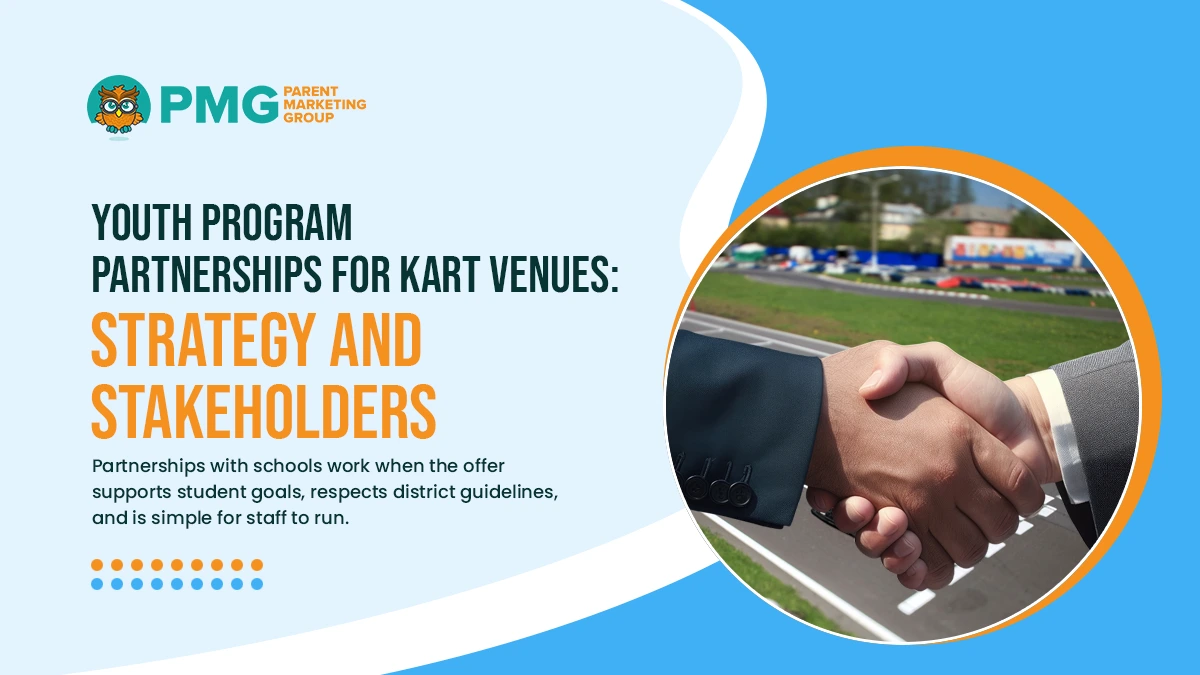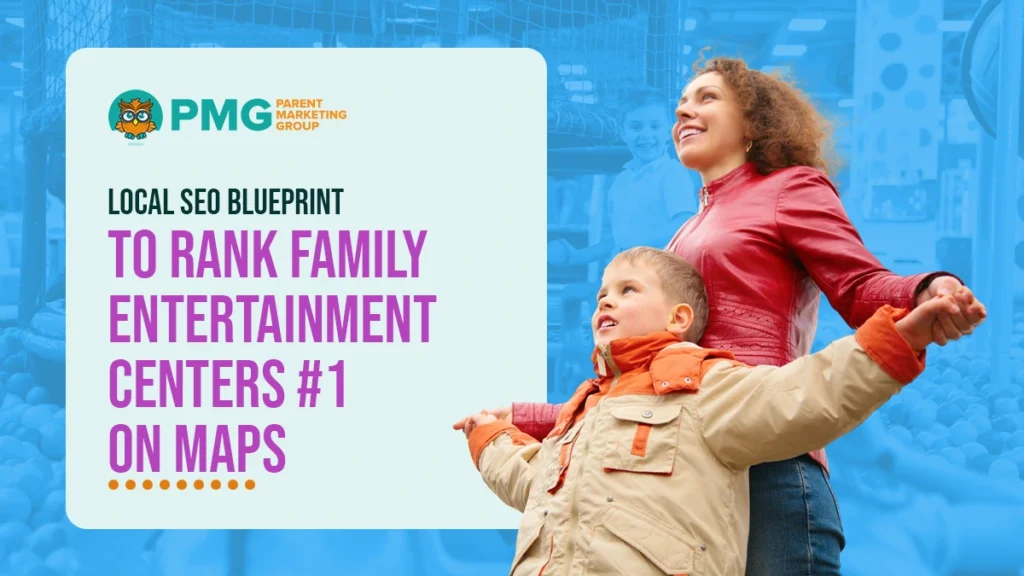School sponsorship marketing for go-kart tracks connects your venue with PTA leaders, athletic directors, and teachers to drive family visits while funding school programs. Effective partnerships bundle a clear offer, like fundraiser race nights, reading-reward laps, or team celebration packages, with simple promotion assets and a shared revenue model.
Provide printable flyers, QR codes, and email copy schools can deploy quickly, and reserve peak-friendly time blocks so families can attend together. Track outcomes with unique codes, UTM links, and POS tags tied to each school to measure foot traffic, deposits, and average order value. Align with district guidelines, confirm approval steps, and set a repeatable calendar across semesters.
Youth Program Partnerships for Kart Venues: Strategy and Stakeholders

Partnerships with schools work when the offer supports student goals, respects district guidelines, and is simple for staff to run. Start with a clear strategy, define ownership on both sides, and document how results will be measured and reported.
Program Goals and Fit
Clarify why the venue is partnering and how the school benefits, then align the format to community needs.
- Primary objective: State whether the focus is fundraising, attendance incentives, or team celebrations.
- Audience scope: Identify grades, teams, clubs, and accessibility needs to shape capacity and policies.
- Value exchange: Outline shared revenue, scholarship tickets, or in-kind support for school programs.
- Success metrics: Set targets for visits, deposits, average order value, and return visits by school.
A brief helps administrators validate the concept quickly and reduces back-and-forth.
School and Community Stakeholders
Map decision-makers and day-to-day contacts to keep approvals moving and communications consistent.
- PTA and booster leaders: Coordinate calendars, promotion channels, and volunteer support.
- Athletic directors and coaches: Align postseason celebrations and team nights with practice schedules.
- Principals and district liaisons: Confirm policy compliance, insurance needs, and media permissions.
- Club advisors and counselors: Connect academic clubs, STEM teams, or reading programs to incentives.
Maintain a single point of contact list with roles, emails, and phone numbers for quick coordination.
Venue Roles and Accountability
Assign internal owners so planning, staffing, and reporting stay on schedule.
- Outreach lead: Manages school relationships, approvals, and distribution of co-branded assets.
- Operations coordinator: Reserves time blocks, sets buffers, and ensures waiver and safety briefings.
- Finance and reporting: Tracks codes, UTM links, and POS tags; issues post-event summaries.
- Creative and web support: Builds landing pages, QR flyers, and email copy for school use.
Weekly check-ins keep the program on track and allow for timely adjustments.
Governance, Approval, and Timing
Follow district rules and publish a straightforward timeline that schools can adopt each term.
- Policy alignment: Document sponsorship rules, gift limits, and advertising restrictions.
- Required documents: Prepare insurance certificates and facility use forms, and hold harmless agreements.
- Lead times: Propose outreach, promotion, and event dates that avoid exams and major school events.
- Equity considerations: Offer low-cost options and translation-ready materials for wider access.
With clear roles, approvals, and dates, partnerships scale across multiple schools with consistent results.
Event Sponsorship With Local Schools: Models and Mechanics

School partnerships work best when the event format is simple, easy to promote, and measurable. Choose one or more models that fit district policies, family schedules, and your track’s capacity.
Fundraiser Race Nights
A single evening with shared revenue creates clear purpose and momentum. Publish terms in advance and cap attendance for quality.
- Revenue share: Define a simple percentage and a payout window that the school can plan around.
- Family bundle: Offer per-guest pricing, which includes laps, reserved seating, and a drink ticket.
- Capacity plan: Set time blocks, buffers, and staff ratios to protect throughput.
- Tracking code: Assign a school code on flyers and POS to attribute sales.
Close with a post-event summary that shows visits, sales, and funds raised.
Vouchers and Read-to-Ride Programs
Voucher programs reward positive milestones and reach families unable to attend a single-night event.
- Earning rules: Tie vouchers to reading logs, attendance goals, or STEM achievements.
- Redemption window: Provide several weeks with blackout dates noted on the voucher.
- Limit controls: Define one voucher per student and an add-on path for siblings.
- Verification: Use QR or alphanumeric codes that validate at the counter.
These programs build goodwill and steady traffic without pressure on one calendar slot.
Team and Club Packages
Celebration packages align with seasons and encourage group bookings with predictable inclusions.
- Tiered options: Offer Basic, Deluxe, and All-Inclusive versions sized to typical rosters.
- Host support: Include a party host to manage pacing, photos, and room turnover.
- Food bundles: Pre-set pizza and pitcher quantities that match average headcounts.
- Photo moment: Reserve a podium or banner spot for team pictures.
Provide a simple deposit policy and a reschedule window that respects tournament weekends.
Approval Workflow and Facility Requirements
Clear approvals reduce delays and protect both the venue and the school. Prepare documents before outreach.
- District forms: Collect required sponsorship approvals and facility use agreements.
- Insurance certificates: Share COI with the named insured’s language if requested.
- Safety standards: Document age and height rules, waivers, and briefing steps.
- Payment terms: Confirm payout method, timing, and reporting format.
A short checklist with dates and owners keeps the program compliant and repeatable across schools.
Community Outreach for Family Entertainment: Channels and Messaging

Community outreach works when schools and families can share information quickly and clearly. Use established channels, supply ready-to-use assets, and keep messages consistent across print and digital placements.
In-School Communication Channels
Prioritize the channels schools already trust and use weekly. Provide editable files and short copy blocks to reduce staff workload.
- E-Newsletter Blurbs: 60–90 word updates with a school-specific link and code.
- Classroom Flyers: One-page PDFs with QR codes and simple redemption steps.
- Morning Announcements: Two-sentence scripts that highlight date and purpose.
- Staff Room Posters: Quick-reference sheets that explain how to participate.
Share final proofs for approval and confirm send dates so promotion cadence matches the school calendar.
Community and Partner Networks
Extend reach through organizations that families already engage with outside school hours. Coordinate timing around practices, meetings, and library events.
- Youth Leagues and Clubs: Short posts for team apps and coach emails.
- Libraries and Parks: Counter cards and digital slides for community boards.
- Chambers and PTAs: Co-branded posts for social pages and newsletters.
- Local Parenting Groups: Pre-approved copy for moderators and group rules.
Track which partners drive scans and visits, then give them tailored assets for the subsequent activation.
Message Pillars and Copy Standards
Keep messaging clear, family-friendly, and aligned with school expectations. Focus on safety, value, and the positive impact on programs.
- Safety and Supervision: Briefly note age and height checks plus on-site hosts.
- Active Fun and Inclusion: Emphasize accessible play and space for all guests.
- Fundraising Impact: State how each visit contributes to school goals.
- Simple Next Step: Provide one link, code, and plain instructions.
Use a consistent voice across all placements so families recognize the program and understand how to participate.
Equity, Access, and Language Support
Reduce barriers so every family can take part. Offer alternatives that respect cost, schedule, and language needs.
- Low-Cost Windows: Publish value time blocks and scholarship ticket options.
- Transit and Parking Notes: Include directions and expected parking fees.
- Multilingual Materials: Provide flyers and landing pages in the dominant local languages.
- Accessibility Details: Share stroller paths, seating options, and assistance contacts.
Close each asset with a simple help path, such as an email or phone number, so that organizers can answer questions quickly.
Offer Design and Value Proposition
Design the offer so families see clear value at each step and staff can reliably deliver the experience. Packages should correspond to common party sizes, planning windows, and budgets, with inclusions that remove work for organizers.
Tiered Packages and Roles
Use a three-tier ladder so choices are simple and upgrades are obvious. Names and roles should be consistent across the web, flyers, and phone scripts.
- Basic (Value Anchor): Secures track time and a reserved table for a set headcount.
- Deluxe (Most Popular): Adds a party host, extended play, and bundled food and beverage.
- Ultimate (All-Inclusive): Includes premium décor, priority start windows, and a structured photo moment.
State the purpose of each tier in one line so parents can self-select without additional guidance.
Inclusions That Solve Parent Problems
Frame inclusions as solutions to common planning pain points. Keep descriptions brief and operationally precise.
- Time and Flow: Defined track time, staging windows, and buffers that protect pacing.
- Hosted Support: A named host for check-in, transitions, and coordination with kitchen staff.
- Food and Beverage: Pre-set bundles sized to typical rosters with clear refill rules.
- Space and Storage: Reserved seating, a cake table, and secure gift storage.
- Memories: A designated photo spot and optional medal presentation for the birthday guest.
List exactly what is included and where each element occurs to prevent day-of confusion.
Pricing Structure and Transparency
Choose a pricing model that protects margins and reads clearly to families. Publish totals with taxes, fees, and deposits before checkout.
- Per-Guest vs. Flat Rate: Pick the model that aligns with average party size and throughput.
- Deposit Rules: Set deposit amount, due date, and refund or credit outcomes.
- Upgrade Deltas: Show the added cost of moving from Basic to Deluxe and from Deluxe to Ultimate.
- Add-On Price Fences: Price items so bundles remain the best value without hidden charges.
Display one all-in estimate on the review screen with an itemized breakdown below.
Policies That Reduce Friction
Simple policies protect capacity and keep expectations aligned. Surface them on the package page and in confirmations.
- Reschedules: Allow moves within a defined window with clear instructions.
- Headcount Adjustments: Offer a small same-week adjustment range for accuracy.
- Weather Plan: Outline indoor alternatives or credit paths for closures.
- Waivers and Eligibility: Provide digital waivers and state age or height requirements.
Close each package card with a short “What to Expect” panel that links to full terms.
Conclusion
Successful school partnerships feel straightforward for administrators and genuinely helpful to families. When the offer is clear, the calendar realistic, and the measurement honest, schools receive visible support, and your track earns steady, local foot traffic. Over time, these relationships create familiar rituals—fundraiser nights, season wrap-ups, reading rewards—that parents plan around and students look forward to.
Want a sponsorship program that consistently drives family visits and funds school goals? Call (716) 303-4133
or visit https://parentmarketing.com/contact-us.






